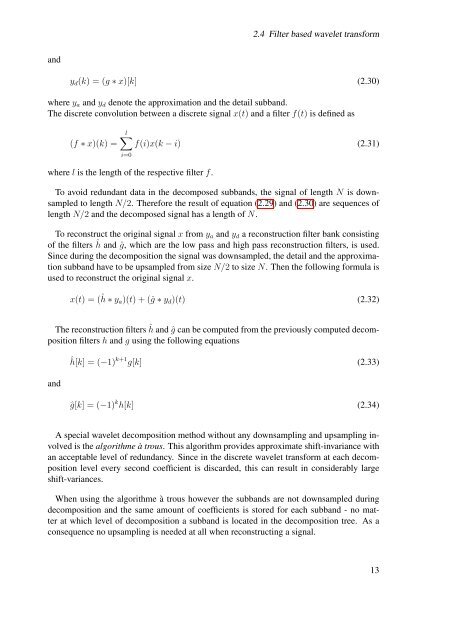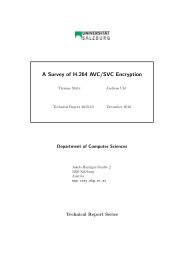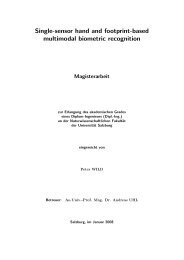Pit Pattern Classification in Colonoscopy using Wavelets - WaveLab
Pit Pattern Classification in Colonoscopy using Wavelets - WaveLab
Pit Pattern Classification in Colonoscopy using Wavelets - WaveLab
You also want an ePaper? Increase the reach of your titles
YUMPU automatically turns print PDFs into web optimized ePapers that Google loves.
2.4 Filter based wavelet transform<br />
and<br />
y d (k) = (g ∗ x)[k] (2.30)<br />
where y a and y d denote the approximation and the detail subband.<br />
The discrete convolution between a discrete signal x(t) and a filter f(t) is def<strong>in</strong>ed as<br />
(f ∗ x)(k) =<br />
l∑<br />
f(i)x(k − i) (2.31)<br />
i=0<br />
where l is the length of the respective filter f.<br />
To avoid redundant data <strong>in</strong> the decomposed subbands, the signal of length N is downsampled<br />
to length N/2. Therefore the result of equation (2.29) and (2.30) are sequences of<br />
length N/2 and the decomposed signal has a length of N.<br />
To reconstruct the orig<strong>in</strong>al signal x from y a and y d a reconstruction filter bank consist<strong>in</strong>g<br />
of the filters ĥ and ĝ, which are the low pass and high pass reconstruction filters, is used.<br />
S<strong>in</strong>ce dur<strong>in</strong>g the decomposition the signal was downsampled, the detail and the approximation<br />
subband have to be upsampled from size N/2 to size N. Then the follow<strong>in</strong>g formula is<br />
used to reconstruct the orig<strong>in</strong>al signal x.<br />
x(t) = (ĥ ∗ y a)(t) + (ĝ ∗ y d )(t) (2.32)<br />
The reconstruction filters ĥ and ĝ can be computed from the previously computed decomposition<br />
filters h and g us<strong>in</strong>g the follow<strong>in</strong>g equations<br />
ĥ[k] = (−1) k+1 g[k] (2.33)<br />
and<br />
ĝ[k] = (−1) k h[k] (2.34)<br />
A special wavelet decomposition method without any downsampl<strong>in</strong>g and upsampl<strong>in</strong>g <strong>in</strong>volved<br />
is the algorithme à trous. This algorithm provides approximate shift-<strong>in</strong>variance with<br />
an acceptable level of redundancy. S<strong>in</strong>ce <strong>in</strong> the discrete wavelet transform at each decomposition<br />
level every second coefficient is discarded, this can result <strong>in</strong> considerably large<br />
shift-variances.<br />
When us<strong>in</strong>g the algorithme à trous however the subbands are not downsampled dur<strong>in</strong>g<br />
decomposition and the same amount of coefficients is stored for each subband - no matter<br />
at which level of decomposition a subband is located <strong>in</strong> the decomposition tree. As a<br />
consequence no upsampl<strong>in</strong>g is needed at all when reconstruct<strong>in</strong>g a signal.<br />
13








